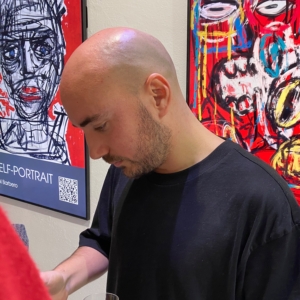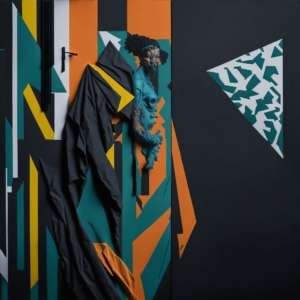SUPERANDO LAS BARRERAS EXPRESIVAS FRENTE A LA RESISTENCIA DEL MERCADO DEL ARTE
El arte ha sido una forma poderosa de expresión humana a lo largo de la historia, capaz de trascender barreras culturales y comunicar ideas de manera única. Sin embargo, mientras el arte tiende a romper las fronteras expresivas y evolucionar constantemente, el mercado del arte ha sido históricamente resistente al cambio y a la evolución. En este artículo, exploraremos cómo el arte desafía las limitaciones impuestas y cómo el mercado del arte puede adaptarse para fomentar la innovación y la expresión artística.
EL ARTE COMO MEDIO DE RUPTURA
Desde las pinturas rupestres en cuevas prehistóricas hasta las instalaciones contemporáneas, el arte ha desempeñado un papel fundamental en la expresión de las experiencias humanas. Los artistas a menudo se han rebelado contra las convenciones sociales y han desafiado las normas establecidas para explorar nuevas formas de expresión. A través de su creatividad y originalidad, los artistas han logrado romper las barreras impuestas por la sociedad y liberar su imaginación.
El arte experimental y vanguardista del siglo XX es un ejemplo destacado de cómo el arte ha desafiado las convenciones establecidas. Movimientos como el dadaísmo, el surrealismo y el expresionismo abstracto exploraron nuevas técnicas, materiales y conceptos artísticos que sacudieron los cimientos de la tradición. Estos artistas buscaron empujar los límites del arte y expandir las posibilidades expresivas, cuestionando las normas establecidas y desafiando las expectativas del público.
RESISTENCIA DEL MERCADO DEL ARTE
A pesar de la tendencia del arte a la ruptura y la evolución, el mercado del arte ha mostrado históricamente resistencia a los cambios significativos. El mercado del arte, en muchos aspectos, ha estado arraigado en la tradición y ha favorecido la comercialización de estilos y artistas establecidos. Esta mentalidad conservadora ha llevado a la persistencia de un canon artístico dominante y ha dificultado la aceptación de nuevas formas de expresión.
La comercialización del arte ha llevado a la creación de una jerarquía de valor donde ciertos artistas y estilos son considerados más «valiosos» que otros. Esta jerarquía a menudo se basa en el reconocimiento de nombres conocidos y en la creación de una demanda impulsada por el prestigio y la inversión. Como resultado, los artistas emergentes y los enfoques artísticos innovadores pueden tener dificultades para encontrar su lugar en el mercado del arte establecido.
SUPERANDO LAS BARRERAS
A pesar de los desafíos presentados por el mercado del arte, existen iniciativas que buscan superar las barreras y fomentar la evolución artística. Las galerías y museos contemporáneos están explorando nuevas formas de presentar y promover el arte innovador. No podemos olvidar que existen iniciativas en este sentido desde los años ochentas, con más o menos éxito; así, los espacios Supermarché Art intentaron atraer la mirada de pequeños coleccionistas con obras de artistas noveles, con formatos más asequibles. También algunas ferias de arte irrumpieron frente a los grandes eventos como fórmula alternativa. Además, la digitalización ha brindado oportunidades sin precedentes para que los artistas lleguen directamente a su audiencia, evitando las restricciones tradicionales del mercado del arte.
Los coleccionistas y amantes del arte también pueden desempeñar un papel en la ruptura de las barreras expresivas. Al apoyar a artistas emergentes y explorar nuevas formas de arte, pueden contribuir a la diversidad y la evolución del panorama artístico. El reconocimiento de la importancia de la expresión personal y la apertura a nuevas perspectivas son fundamentales para fomentar un mercado del arte más inclusivo y receptivo al cambio.
Al apoyar a artistas emergentes y abrazar la diversidad podemos construir un mercado del arte más dinámico y enriquecedor, que promueva la innovación y celebre la libertad expresiva.
OVERCOMING EXPRESSIVE BARRIERS IN THE FACE OF ART MARKET RESISTANCE
Throughout history, art has been a powerful form of human expression, capable of transcending cultural barriers and communicating ideas in unique ways. However, the art market has historically been resistant to change and evolution, despite the fact that art tends to break down expressive boundaries and constantly evolve. This article explores how art can transcend imposed limitations and how the art market can encourage innovation and artistic expression.
ART AS A MEDIUM OF RUPTURE
Art has played a fundamental role in the expression of human experiences, from prehistoric cave paintings to contemporary installations. Through their creativity and originality, artists have often rebelled against social conventions and challenged established norms to explore new forms of expression. By doing so, they have managed to break down the barriers imposed by society and free their imagination.
The experimental and avant-garde art movements of the 20th century challenged established conventions. Dadaism, Surrealism, and Abstract Expressionism explored new techniques, materials, and artistic concepts that questioned established norms and expanded expressive possibilities. The artists sought to push the boundaries of art and challenge public expectations.
RESISTANCE OF THE ART MARKET
Despite art’s tendency to evolve and rupture, the art market has historically shown resistance to significant change. The art market has been rooted in tradition and has favoured the commercialisation of established styles and artists. This conservative mentality has led to the persistence of a dominant artistic canon and has hindered the acceptance of new forms of expression.
The commercialisation of art has resulted in the establishment of a value hierarchy, where certain artists and styles are deemed more valuable than others. This hierarchy is often based on name recognition and demand driven by prestige and investment. Consequently, emerging artists and innovative artistic approaches may face difficulties in finding their place in the established art market.
OVERCOMING BARRIERS
Although the art market presents challenges, there are initiatives that aim to overcome these barriers and encourage artistic evolution. Contemporary galleries and museums are exploring new ways to present and promote innovative art. It is important to acknowledge that there have been previous attempts to address this issue since the 1980s, with varying degrees of success. For instance, Supermarché Art spaces attempted to appeal to small collectors by showcasing works by new artists in more affordable formats. Similarly, some art fairs have emerged as an alternative to larger events. Furthermore, digitalisation has provided artists with unprecedented opportunities to directly reach their audience, bypassing traditional constraints of the art market.
Collectors and art enthusiasts can also contribute to breaking down expressive barriers by supporting emerging artists and exploring new art forms. Collectors and art enthusiasts can also contribute to breaking down expressive barriers by supporting emerging artists and exploring new art forms. Collectors and art enthusiasts can also contribute to breaking down expressive barriers by supporting emerging artists and exploring new art forms. This can help to promote diversity and evolution within the art scene. It is important to recognise the significance of self-expression and openness to new perspectives in fostering a more inclusive art market that is receptive to change.
Supporting emerging artists and embracing diversity can create a more dynamic and enriching art market that promotes innovation and celebrates expressive freedom.




